Strategic Report: Tesla's Entrepreneurial Opportunities
VerifiedAdded on 2020/11/12
|13
|3389
|252
Report
AI Summary
This strategic report provides a comprehensive analysis of Tesla Motors Inc., examining its internal resources, capabilities, and competitive advantages. The report delves into the key drivers of change in the external environment, utilizing PESTEL analysis to evaluate their impact on Tesla's entrepreneurial activities. Furthermore, it employs Porter's Five Forces model to assess the competitive forces influencing the automobile industry and Tesla's profitability. The report then evaluates strategic options, including the Bowman Strategy Clock and Ansoff Matrix, to identify opportunities for market expansion and increased entrepreneurial ventures. The analysis justifies the selection of each strategic choice using suitability, acceptability, and feasibility criteria, offering valuable insights into Tesla's strategic positioning and future growth prospects.

STRATEGIC REPORT
Paraphrase This Document
Need a fresh take? Get an instant paraphrase of this document with our AI Paraphraser

TABLE OF CONTENTS
INTRODUCTION...........................................................................................................................3
SECTION 1......................................................................................................................................3
a). Critically analyze the internal resources and capabilities that give Tesla a competitive
advantage.....................................................................................................................................3
b). Identify key drivers of change in external environment and evaluate their impact on the
entrepreneurial activities of Tesla................................................................................................5
c). Evaluate impact of main competitive forces that are influencing entrepreneurial activities
and profitability within automobile industry by using appropriate framework...........................6
SECTION 2......................................................................................................................................8
a). Select and critically evaluate two strategic options that could be recommended for Tesla in
order to increase entrepreneurial opportunities on the market....................................................8
b). Justify selection of each strategic choice using suitability, Acceptability and Feasibility
(SAFe) criteria.............................................................................................................................9
CONCLUSION .............................................................................................................................10
REFERENCES..............................................................................................................................12
INTRODUCTION...........................................................................................................................3
SECTION 1......................................................................................................................................3
a). Critically analyze the internal resources and capabilities that give Tesla a competitive
advantage.....................................................................................................................................3
b). Identify key drivers of change in external environment and evaluate their impact on the
entrepreneurial activities of Tesla................................................................................................5
c). Evaluate impact of main competitive forces that are influencing entrepreneurial activities
and profitability within automobile industry by using appropriate framework...........................6
SECTION 2......................................................................................................................................8
a). Select and critically evaluate two strategic options that could be recommended for Tesla in
order to increase entrepreneurial opportunities on the market....................................................8
b). Justify selection of each strategic choice using suitability, Acceptability and Feasibility
(SAFe) criteria.............................................................................................................................9
CONCLUSION .............................................................................................................................10
REFERENCES..............................................................................................................................12
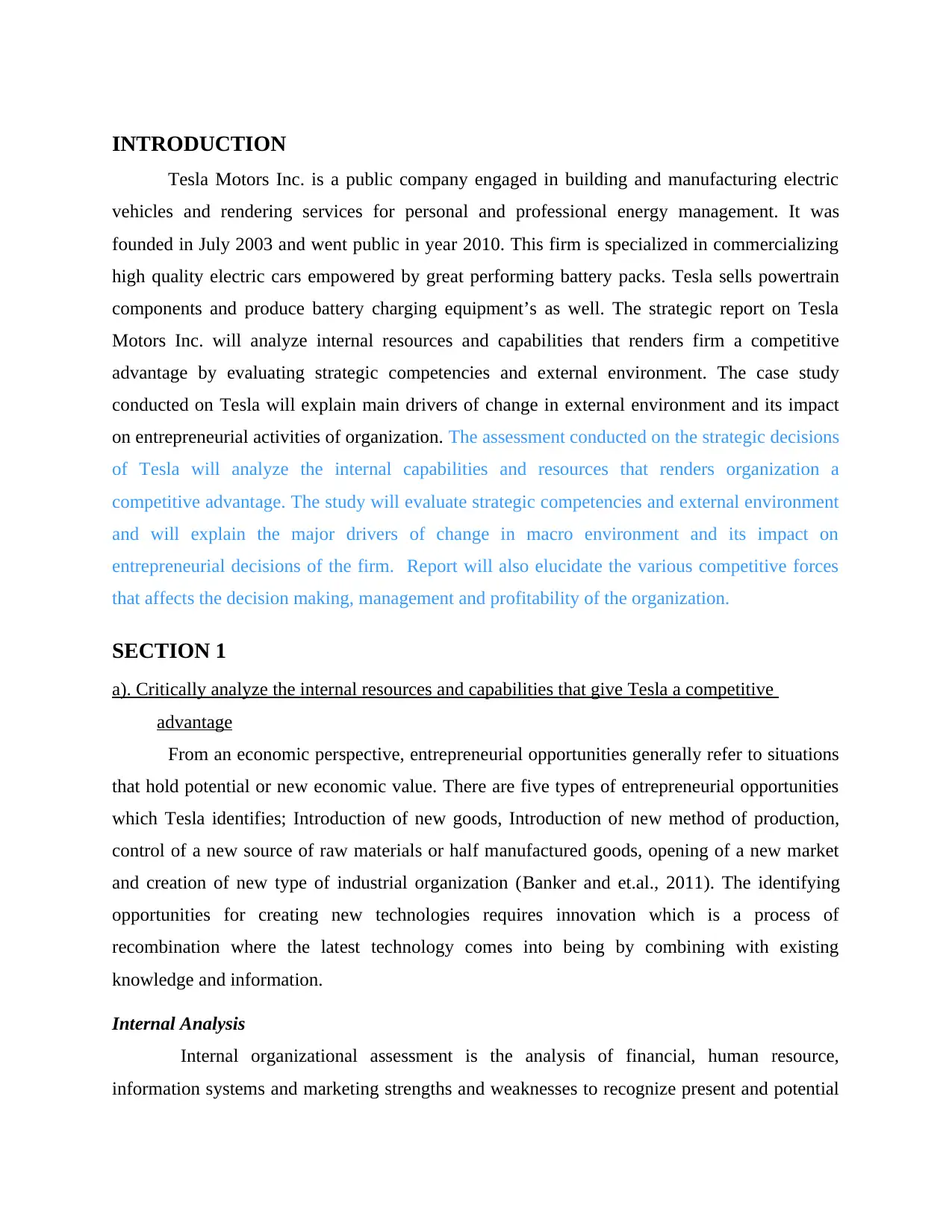
INTRODUCTION
Tesla Motors Inc. is a public company engaged in building and manufacturing electric
vehicles and rendering services for personal and professional energy management. It was
founded in July 2003 and went public in year 2010. This firm is specialized in commercializing
high quality electric cars empowered by great performing battery packs. Tesla sells powertrain
components and produce battery charging equipment’s as well. The strategic report on Tesla
Motors Inc. will analyze internal resources and capabilities that renders firm a competitive
advantage by evaluating strategic competencies and external environment. The case study
conducted on Tesla will explain main drivers of change in external environment and its impact
on entrepreneurial activities of organization. The assessment conducted on the strategic decisions
of Tesla will analyze the internal capabilities and resources that renders organization a
competitive advantage. The study will evaluate strategic competencies and external environment
and will explain the major drivers of change in macro environment and its impact on
entrepreneurial decisions of the firm. Report will also elucidate the various competitive forces
that affects the decision making, management and profitability of the organization.
SECTION 1
a). Critically analyze the internal resources and capabilities that give Tesla a competitive
advantage
From an economic perspective, entrepreneurial opportunities generally refer to situations
that hold potential or new economic value. There are five types of entrepreneurial opportunities
which Tesla identifies; Introduction of new goods, Introduction of new method of production,
control of a new source of raw materials or half manufactured goods, opening of a new market
and creation of new type of industrial organization (Banker and et.al., 2011). The identifying
opportunities for creating new technologies requires innovation which is a process of
recombination where the latest technology comes into being by combining with existing
knowledge and information.
Internal Analysis
Internal organizational assessment is the analysis of financial, human resource,
information systems and marketing strengths and weaknesses to recognize present and potential
Tesla Motors Inc. is a public company engaged in building and manufacturing electric
vehicles and rendering services for personal and professional energy management. It was
founded in July 2003 and went public in year 2010. This firm is specialized in commercializing
high quality electric cars empowered by great performing battery packs. Tesla sells powertrain
components and produce battery charging equipment’s as well. The strategic report on Tesla
Motors Inc. will analyze internal resources and capabilities that renders firm a competitive
advantage by evaluating strategic competencies and external environment. The case study
conducted on Tesla will explain main drivers of change in external environment and its impact
on entrepreneurial activities of organization. The assessment conducted on the strategic decisions
of Tesla will analyze the internal capabilities and resources that renders organization a
competitive advantage. The study will evaluate strategic competencies and external environment
and will explain the major drivers of change in macro environment and its impact on
entrepreneurial decisions of the firm. Report will also elucidate the various competitive forces
that affects the decision making, management and profitability of the organization.
SECTION 1
a). Critically analyze the internal resources and capabilities that give Tesla a competitive
advantage
From an economic perspective, entrepreneurial opportunities generally refer to situations
that hold potential or new economic value. There are five types of entrepreneurial opportunities
which Tesla identifies; Introduction of new goods, Introduction of new method of production,
control of a new source of raw materials or half manufactured goods, opening of a new market
and creation of new type of industrial organization (Banker and et.al., 2011). The identifying
opportunities for creating new technologies requires innovation which is a process of
recombination where the latest technology comes into being by combining with existing
knowledge and information.
Internal Analysis
Internal organizational assessment is the analysis of financial, human resource,
information systems and marketing strengths and weaknesses to recognize present and potential
⊘ This is a preview!⊘
Do you want full access?
Subscribe today to unlock all pages.

Trusted by 1+ million students worldwide

competitive advantages of Tesla. Effective strategic management requires understanding of
organizational competencies and resources and how each contributes to formation of strengths
and develop a competitive advantage. Tesla’s investment in R&D, capital expenditures and
expenses relating to operations have increased since 2010 and experienced a decrease in cash
flows in 2015. Tesla is in a transition phase and requires consistent and long-term strategies and
action plans for attaining growth. Internal analysis of Tesla will consist of core, distinctive
competencies and competitive advantage. The internal competencies include; power-train
engineering, vehicle engineering, energy storage etc. Distinctive competencies involve battery
life in long travel, self-driving capabilities etc.
Organizational / Financial / Physical resources
Balance sheets for the year ended 2016 of Tesla shows $1.2 billion cash reserve for total
of $8 billion assets (Bini, Dainelli and Giunta, 2016). Tesla owns its factory located in South
Fremont, California which has the capacity to produce 2000 cars per week and another
production unit in Nevada, the gigafactory that is financed by Tesla and Panasonic is working
together to reach an optimal level by 2018 thus lowering costs of batteries to 30%.
Resources
Intangible assets of Tesla include intellectual property right that is clear and consistent
with its vision; ‘all our patent are belonged to you”, brand valuation is complex that combines
benchmark, cost, market and Income based methods. And the value know how is concerned with
electric car and energy storage that is critical in understanding traditional car makers who are
planning to manufacture power charged automobiles by 2018.
Capabilities / Core competencies
The key corporate capabilities of Tesla consists of its Financial management, expertise in
strategic control, effectiveness in motivating and coordinating business units etc. It is a
technology company building technology platforms and thereby positions itself to become a
leading player in energy industry and economy which will bring integration, data analysis and
elegance. Human resources including blend, aptitudes, learning and skills of individuals in
Tesla’s organization network is the greatest tangible asset which it utilizes in its processes and
activities. Capabilities of Tesla that makes them unique and gain a competitive edge over others
are split into two categories; Electric Vehicle Manufacturing (EVM) and High Performance
Battery Manufacturing (HPBM).
organizational competencies and resources and how each contributes to formation of strengths
and develop a competitive advantage. Tesla’s investment in R&D, capital expenditures and
expenses relating to operations have increased since 2010 and experienced a decrease in cash
flows in 2015. Tesla is in a transition phase and requires consistent and long-term strategies and
action plans for attaining growth. Internal analysis of Tesla will consist of core, distinctive
competencies and competitive advantage. The internal competencies include; power-train
engineering, vehicle engineering, energy storage etc. Distinctive competencies involve battery
life in long travel, self-driving capabilities etc.
Organizational / Financial / Physical resources
Balance sheets for the year ended 2016 of Tesla shows $1.2 billion cash reserve for total
of $8 billion assets (Bini, Dainelli and Giunta, 2016). Tesla owns its factory located in South
Fremont, California which has the capacity to produce 2000 cars per week and another
production unit in Nevada, the gigafactory that is financed by Tesla and Panasonic is working
together to reach an optimal level by 2018 thus lowering costs of batteries to 30%.
Resources
Intangible assets of Tesla include intellectual property right that is clear and consistent
with its vision; ‘all our patent are belonged to you”, brand valuation is complex that combines
benchmark, cost, market and Income based methods. And the value know how is concerned with
electric car and energy storage that is critical in understanding traditional car makers who are
planning to manufacture power charged automobiles by 2018.
Capabilities / Core competencies
The key corporate capabilities of Tesla consists of its Financial management, expertise in
strategic control, effectiveness in motivating and coordinating business units etc. It is a
technology company building technology platforms and thereby positions itself to become a
leading player in energy industry and economy which will bring integration, data analysis and
elegance. Human resources including blend, aptitudes, learning and skills of individuals in
Tesla’s organization network is the greatest tangible asset which it utilizes in its processes and
activities. Capabilities of Tesla that makes them unique and gain a competitive edge over others
are split into two categories; Electric Vehicle Manufacturing (EVM) and High Performance
Battery Manufacturing (HPBM).
Paraphrase This Document
Need a fresh take? Get an instant paraphrase of this document with our AI Paraphraser
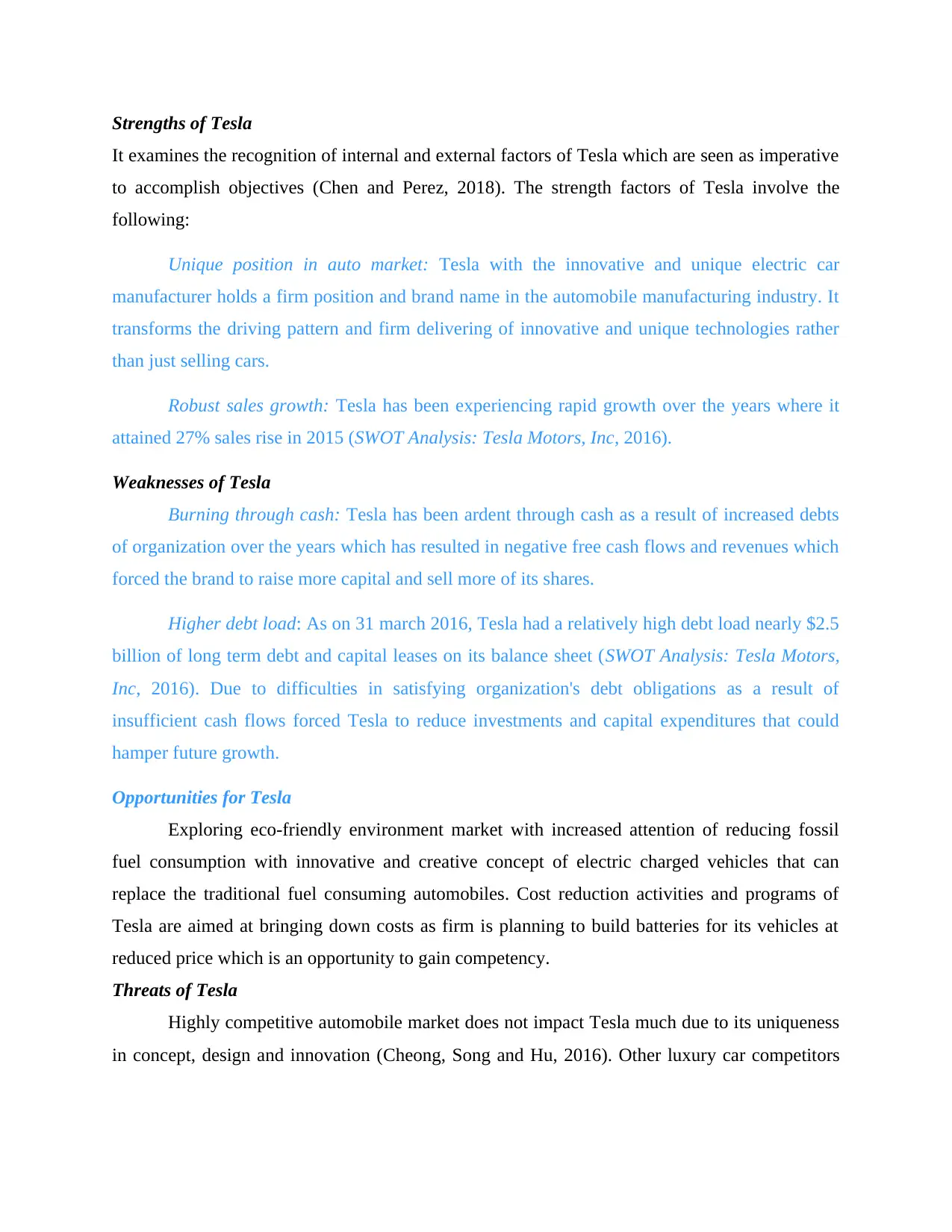
Strengths of Tesla
It examines the recognition of internal and external factors of Tesla which are seen as imperative
to accomplish objectives (Chen and Perez, 2018). The strength factors of Tesla involve the
following:
Unique position in auto market: Tesla with the innovative and unique electric car
manufacturer holds a firm position and brand name in the automobile manufacturing industry. It
transforms the driving pattern and firm delivering of innovative and unique technologies rather
than just selling cars.
Robust sales growth: Tesla has been experiencing rapid growth over the years where it
attained 27% sales rise in 2015 (SWOT Analysis: Tesla Motors, Inc, 2016).
Weaknesses of Tesla
Burning through cash: Tesla has been ardent through cash as a result of increased debts
of organization over the years which has resulted in negative free cash flows and revenues which
forced the brand to raise more capital and sell more of its shares.
Higher debt load: As on 31 march 2016, Tesla had a relatively high debt load nearly $2.5
billion of long term debt and capital leases on its balance sheet (SWOT Analysis: Tesla Motors,
Inc, 2016). Due to difficulties in satisfying organization's debt obligations as a result of
insufficient cash flows forced Tesla to reduce investments and capital expenditures that could
hamper future growth.
Opportunities for Tesla
Exploring eco-friendly environment market with increased attention of reducing fossil
fuel consumption with innovative and creative concept of electric charged vehicles that can
replace the traditional fuel consuming automobiles. Cost reduction activities and programs of
Tesla are aimed at bringing down costs as firm is planning to build batteries for its vehicles at
reduced price which is an opportunity to gain competency.
Threats of Tesla
Highly competitive automobile market does not impact Tesla much due to its uniqueness
in concept, design and innovation (Cheong, Song and Hu, 2016). Other luxury car competitors
It examines the recognition of internal and external factors of Tesla which are seen as imperative
to accomplish objectives (Chen and Perez, 2018). The strength factors of Tesla involve the
following:
Unique position in auto market: Tesla with the innovative and unique electric car
manufacturer holds a firm position and brand name in the automobile manufacturing industry. It
transforms the driving pattern and firm delivering of innovative and unique technologies rather
than just selling cars.
Robust sales growth: Tesla has been experiencing rapid growth over the years where it
attained 27% sales rise in 2015 (SWOT Analysis: Tesla Motors, Inc, 2016).
Weaknesses of Tesla
Burning through cash: Tesla has been ardent through cash as a result of increased debts
of organization over the years which has resulted in negative free cash flows and revenues which
forced the brand to raise more capital and sell more of its shares.
Higher debt load: As on 31 march 2016, Tesla had a relatively high debt load nearly $2.5
billion of long term debt and capital leases on its balance sheet (SWOT Analysis: Tesla Motors,
Inc, 2016). Due to difficulties in satisfying organization's debt obligations as a result of
insufficient cash flows forced Tesla to reduce investments and capital expenditures that could
hamper future growth.
Opportunities for Tesla
Exploring eco-friendly environment market with increased attention of reducing fossil
fuel consumption with innovative and creative concept of electric charged vehicles that can
replace the traditional fuel consuming automobiles. Cost reduction activities and programs of
Tesla are aimed at bringing down costs as firm is planning to build batteries for its vehicles at
reduced price which is an opportunity to gain competency.
Threats of Tesla
Highly competitive automobile market does not impact Tesla much due to its uniqueness
in concept, design and innovation (Cheong, Song and Hu, 2016). Other luxury car competitors

who use standard combustion engines does not affect Tesla much as they offer their unique
innovative products on same prices.
b). Identify key drivers of change in external environment and evaluate their impact on the
entrepreneurial activities of Tesla
PESTEL analysis:
Political: Local and international regulations where governments are looking for CO2
emissions minimizing and are setting public subsidy policies to support citizens in buying zero
emissions automobiles. There are fiscal advantages and discounts in France on buying products
that are ecologically responsible. This would benefit Tesla in producing zero emission electric
cars and has a positive effect on their business.
Economic: Global risk that projected on US stock indexes lead the market around the
world as oil prices are low since their major fall in 2014 which didn’t cause any impact on West
Texas Crude Oil and Brent didn’t break the resistances (Dikmen and Burns, 2016). This means
that oi prices will rise again causing people to shift towards renewable.
Social: Rising popularity of low carbon lifestyle and preference for renewable energy are
the changing social elements that adds an added advantage to Tesla. Increased demand for
sustainable products have risen globally which adds on an advantage to Tesla being a sustainable
and eco-friendly brand concept.
Technological: Decrease in general costs of lithium –ions will allow Tesla to build at
lower cost and increase its profit margin. Partnership with Amazon, Google and IBM is
providing discussions and solving problems related to Tesla’s driving software and use of
artificial intelligence which is raising ethical issues.
Legal: Developments of new products by Tesla must be conducted carefully considering
intellectual property barriers. If, issues related to self-driving decisions become frequent it may
affect Tesla that could postpone deliveries of their products.
Environmental: Ecological findings shows a 21 mutual agreements signed by of 183 countries
engaged to maximum cooperation and movement to reduce global warming by 2100. Main
motive is to reduce fuel consumption, global energy reservation and eliminate environmental
imbalances (Gayle, Tewarie and White 2011). It is a great competitive advantage for Tesla as the
firm creates electric automobiles which are eco-friendly.
innovative products on same prices.
b). Identify key drivers of change in external environment and evaluate their impact on the
entrepreneurial activities of Tesla
PESTEL analysis:
Political: Local and international regulations where governments are looking for CO2
emissions minimizing and are setting public subsidy policies to support citizens in buying zero
emissions automobiles. There are fiscal advantages and discounts in France on buying products
that are ecologically responsible. This would benefit Tesla in producing zero emission electric
cars and has a positive effect on their business.
Economic: Global risk that projected on US stock indexes lead the market around the
world as oil prices are low since their major fall in 2014 which didn’t cause any impact on West
Texas Crude Oil and Brent didn’t break the resistances (Dikmen and Burns, 2016). This means
that oi prices will rise again causing people to shift towards renewable.
Social: Rising popularity of low carbon lifestyle and preference for renewable energy are
the changing social elements that adds an added advantage to Tesla. Increased demand for
sustainable products have risen globally which adds on an advantage to Tesla being a sustainable
and eco-friendly brand concept.
Technological: Decrease in general costs of lithium –ions will allow Tesla to build at
lower cost and increase its profit margin. Partnership with Amazon, Google and IBM is
providing discussions and solving problems related to Tesla’s driving software and use of
artificial intelligence which is raising ethical issues.
Legal: Developments of new products by Tesla must be conducted carefully considering
intellectual property barriers. If, issues related to self-driving decisions become frequent it may
affect Tesla that could postpone deliveries of their products.
Environmental: Ecological findings shows a 21 mutual agreements signed by of 183 countries
engaged to maximum cooperation and movement to reduce global warming by 2100. Main
motive is to reduce fuel consumption, global energy reservation and eliminate environmental
imbalances (Gayle, Tewarie and White 2011). It is a great competitive advantage for Tesla as the
firm creates electric automobiles which are eco-friendly.
⊘ This is a preview!⊘
Do you want full access?
Subscribe today to unlock all pages.

Trusted by 1+ million students worldwide

c). Evaluating impact of competitive forces influencing entrepreneurial activities and
profitability within automobile industry an using appropriate framework
Porters Five Forces Model to analyze competitiveness and profitability
This analysis highlights Tesla’s entry to the markets of Asian countries by developing an
autonomous driving capability with a product expansion strategy like public transport and
trucking while keeping sustainability technology as priority.
Competition: Competitive rivalry of Tesla is a strong driving force as it operates in a
competitive market and its 4 P’s of marketing mix meets its aggressiveness that strengthens firm
to compete with competitors.
Buyer power: Tesla customers can avail car purchase at a lower cost by switching to eco-
friendly driving from traditional fuel consuming vehicles (Kancherla and Daim, 2018).
Threat of substitution: There are only moderate available substitutes to Tesla’s products
and people’s low purchasing volume reduces influences on the brand in some cases rising
bargaining by consumers.
Supplier power: Suppliers of Tesla has moderate level of bargaining power as the firm
has low forward integration and limited control to them in distribution and sale of products.
Threat of substitutes or new entry: Threat of substitutes does not affect Tesla much due
to less switching costs which enables competition in market. This imposes strong customer force
against Tesla’s industry environment and there are not much rivals and performances to this
unique brand which adds an advantage to brand in gaining competitive advantage.
profitability within automobile industry an using appropriate framework
Porters Five Forces Model to analyze competitiveness and profitability
This analysis highlights Tesla’s entry to the markets of Asian countries by developing an
autonomous driving capability with a product expansion strategy like public transport and
trucking while keeping sustainability technology as priority.
Competition: Competitive rivalry of Tesla is a strong driving force as it operates in a
competitive market and its 4 P’s of marketing mix meets its aggressiveness that strengthens firm
to compete with competitors.
Buyer power: Tesla customers can avail car purchase at a lower cost by switching to eco-
friendly driving from traditional fuel consuming vehicles (Kancherla and Daim, 2018).
Threat of substitution: There are only moderate available substitutes to Tesla’s products
and people’s low purchasing volume reduces influences on the brand in some cases rising
bargaining by consumers.
Supplier power: Suppliers of Tesla has moderate level of bargaining power as the firm
has low forward integration and limited control to them in distribution and sale of products.
Threat of substitutes or new entry: Threat of substitutes does not affect Tesla much due
to less switching costs which enables competition in market. This imposes strong customer force
against Tesla’s industry environment and there are not much rivals and performances to this
unique brand which adds an advantage to brand in gaining competitive advantage.
Paraphrase This Document
Need a fresh take? Get an instant paraphrase of this document with our AI Paraphraser

Figure 1: Porters Five Forces Model
(Source: A Strategic Audit of Tesla, Inc.: Electrifying our Future or About to Run out of Energy,
2018)
SECTION 2
a). Critical evaluation of strategic options and recommendations for Tesla in order to increase
entrepreneurial opportunities on the market
1.Bowman Strategy Clock
Tesla can focus on strategy clock option introduced by Cliff Bowman by focusing on
differentiation approach to concentrate on small group of people who are environmentally
conscious, attracted and interested in the brand and its uniqueness (Liu and et.al., 2014). Due to
less scale, capacity and capital Tesla won’t be able to focus on hybrid strategies and compete on
basis of cost. It holds a leadership position in market due to its unique design and leading
innovative technologies that attracts people towards their brand.
2.Ansoff matrix for Tesla to devise an internal marketing growth strategy that may increase
entrepreneurial opportunities
Marketing penetration strategy: Business development plans and marketing of Tesla’s
unique and innovative products like; Model S, Powertrain technology, EV tools in existing and
overseas markets. It should focus on aggressive marketing strategy to increase sales and
revenues. A market penetration strategy can be applied by Tesla, inc as a primary and major
(Source: A Strategic Audit of Tesla, Inc.: Electrifying our Future or About to Run out of Energy,
2018)
SECTION 2
a). Critical evaluation of strategic options and recommendations for Tesla in order to increase
entrepreneurial opportunities on the market
1.Bowman Strategy Clock
Tesla can focus on strategy clock option introduced by Cliff Bowman by focusing on
differentiation approach to concentrate on small group of people who are environmentally
conscious, attracted and interested in the brand and its uniqueness (Liu and et.al., 2014). Due to
less scale, capacity and capital Tesla won’t be able to focus on hybrid strategies and compete on
basis of cost. It holds a leadership position in market due to its unique design and leading
innovative technologies that attracts people towards their brand.
2.Ansoff matrix for Tesla to devise an internal marketing growth strategy that may increase
entrepreneurial opportunities
Marketing penetration strategy: Business development plans and marketing of Tesla’s
unique and innovative products like; Model S, Powertrain technology, EV tools in existing and
overseas markets. It should focus on aggressive marketing strategy to increase sales and
revenues. A market penetration strategy can be applied by Tesla, inc as a primary and major
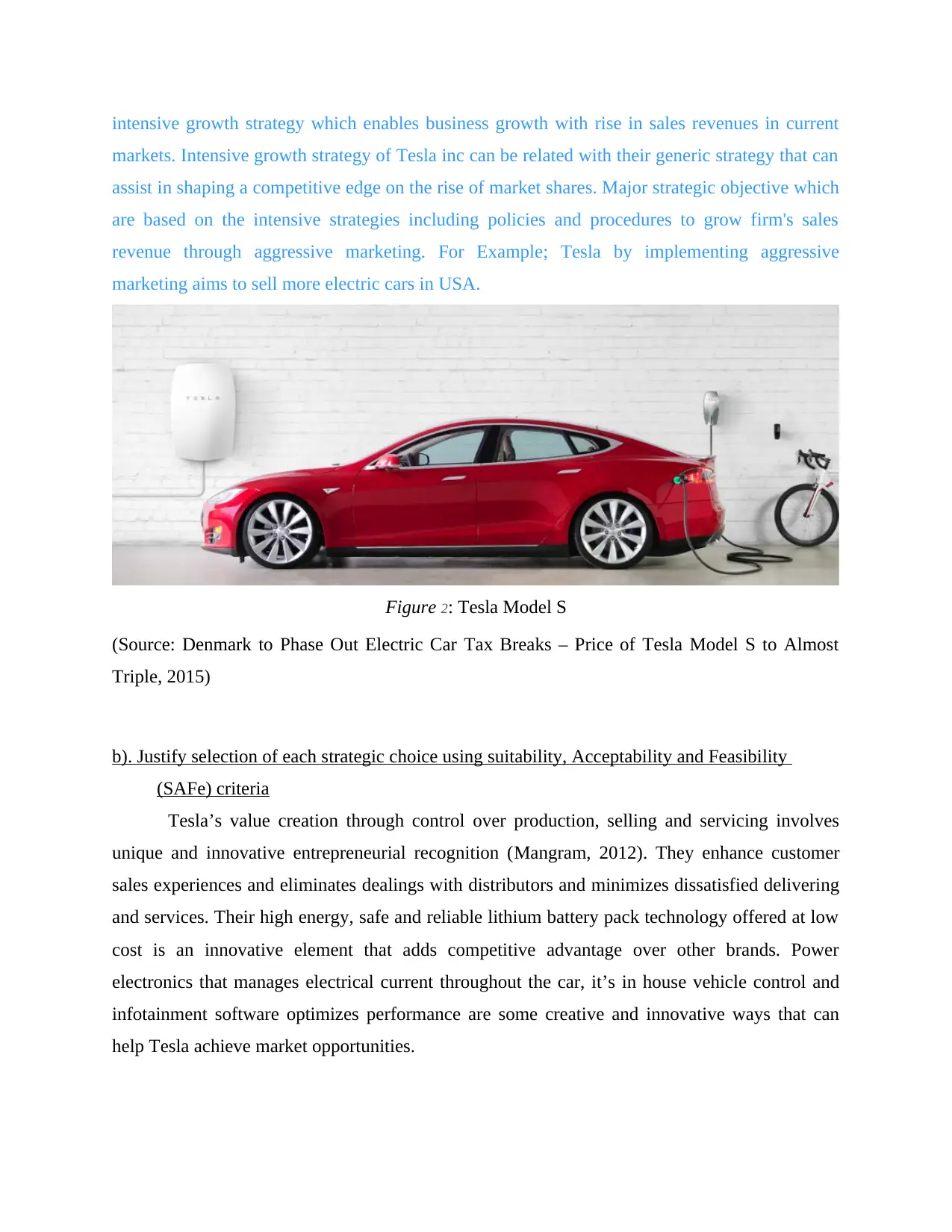
intensive growth strategy which enables business growth with rise in sales revenues in current
markets. Intensive growth strategy of Tesla inc can be related with their generic strategy that can
assist in shaping a competitive edge on the rise of market shares. Major strategic objective which
are based on the intensive strategies including policies and procedures to grow firm's sales
revenue through aggressive marketing. For Example; Tesla by implementing aggressive
marketing aims to sell more electric cars in USA.
Figure 2: Tesla Model S
(Source: Denmark to Phase Out Electric Car Tax Breaks – Price of Tesla Model S to Almost
Triple, 2015)
b). Justify selection of each strategic choice using suitability, Acceptability and Feasibility
(SAFe) criteria
Tesla’s value creation through control over production, selling and servicing involves
unique and innovative entrepreneurial recognition (Mangram, 2012). They enhance customer
sales experiences and eliminates dealings with distributors and minimizes dissatisfied delivering
and services. Their high energy, safe and reliable lithium battery pack technology offered at low
cost is an innovative element that adds competitive advantage over other brands. Power
electronics that manages electrical current throughout the car, it’s in house vehicle control and
infotainment software optimizes performance are some creative and innovative ways that can
help Tesla achieve market opportunities.
markets. Intensive growth strategy of Tesla inc can be related with their generic strategy that can
assist in shaping a competitive edge on the rise of market shares. Major strategic objective which
are based on the intensive strategies including policies and procedures to grow firm's sales
revenue through aggressive marketing. For Example; Tesla by implementing aggressive
marketing aims to sell more electric cars in USA.
Figure 2: Tesla Model S
(Source: Denmark to Phase Out Electric Car Tax Breaks – Price of Tesla Model S to Almost
Triple, 2015)
b). Justify selection of each strategic choice using suitability, Acceptability and Feasibility
(SAFe) criteria
Tesla’s value creation through control over production, selling and servicing involves
unique and innovative entrepreneurial recognition (Mangram, 2012). They enhance customer
sales experiences and eliminates dealings with distributors and minimizes dissatisfied delivering
and services. Their high energy, safe and reliable lithium battery pack technology offered at low
cost is an innovative element that adds competitive advantage over other brands. Power
electronics that manages electrical current throughout the car, it’s in house vehicle control and
infotainment software optimizes performance are some creative and innovative ways that can
help Tesla achieve market opportunities.
⊘ This is a preview!⊘
Do you want full access?
Subscribe today to unlock all pages.

Trusted by 1+ million students worldwide
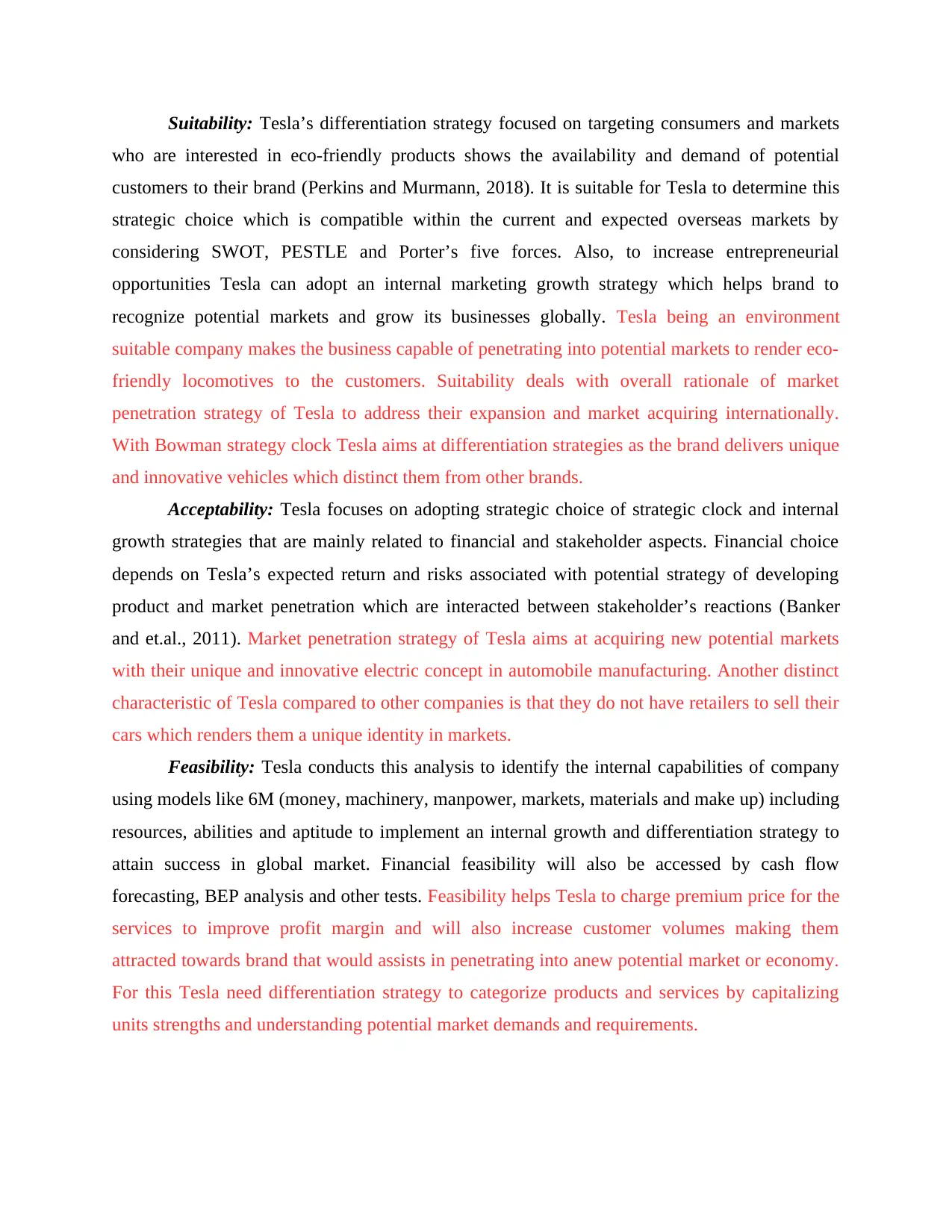
Suitability: Tesla’s differentiation strategy focused on targeting consumers and markets
who are interested in eco-friendly products shows the availability and demand of potential
customers to their brand (Perkins and Murmann, 2018). It is suitable for Tesla to determine this
strategic choice which is compatible within the current and expected overseas markets by
considering SWOT, PESTLE and Porter’s five forces. Also, to increase entrepreneurial
opportunities Tesla can adopt an internal marketing growth strategy which helps brand to
recognize potential markets and grow its businesses globally. Tesla being an environment
suitable company makes the business capable of penetrating into potential markets to render eco-
friendly locomotives to the customers. Suitability deals with overall rationale of market
penetration strategy of Tesla to address their expansion and market acquiring internationally.
With Bowman strategy clock Tesla aims at differentiation strategies as the brand delivers unique
and innovative vehicles which distinct them from other brands.
Acceptability: Tesla focuses on adopting strategic choice of strategic clock and internal
growth strategies that are mainly related to financial and stakeholder aspects. Financial choice
depends on Tesla’s expected return and risks associated with potential strategy of developing
product and market penetration which are interacted between stakeholder’s reactions (Banker
and et.al., 2011). Market penetration strategy of Tesla aims at acquiring new potential markets
with their unique and innovative electric concept in automobile manufacturing. Another distinct
characteristic of Tesla compared to other companies is that they do not have retailers to sell their
cars which renders them a unique identity in markets.
Feasibility: Tesla conducts this analysis to identify the internal capabilities of company
using models like 6M (money, machinery, manpower, markets, materials and make up) including
resources, abilities and aptitude to implement an internal growth and differentiation strategy to
attain success in global market. Financial feasibility will also be accessed by cash flow
forecasting, BEP analysis and other tests. Feasibility helps Tesla to charge premium price for the
services to improve profit margin and will also increase customer volumes making them
attracted towards brand that would assists in penetrating into anew potential market or economy.
For this Tesla need differentiation strategy to categorize products and services by capitalizing
units strengths and understanding potential market demands and requirements.
who are interested in eco-friendly products shows the availability and demand of potential
customers to their brand (Perkins and Murmann, 2018). It is suitable for Tesla to determine this
strategic choice which is compatible within the current and expected overseas markets by
considering SWOT, PESTLE and Porter’s five forces. Also, to increase entrepreneurial
opportunities Tesla can adopt an internal marketing growth strategy which helps brand to
recognize potential markets and grow its businesses globally. Tesla being an environment
suitable company makes the business capable of penetrating into potential markets to render eco-
friendly locomotives to the customers. Suitability deals with overall rationale of market
penetration strategy of Tesla to address their expansion and market acquiring internationally.
With Bowman strategy clock Tesla aims at differentiation strategies as the brand delivers unique
and innovative vehicles which distinct them from other brands.
Acceptability: Tesla focuses on adopting strategic choice of strategic clock and internal
growth strategies that are mainly related to financial and stakeholder aspects. Financial choice
depends on Tesla’s expected return and risks associated with potential strategy of developing
product and market penetration which are interacted between stakeholder’s reactions (Banker
and et.al., 2011). Market penetration strategy of Tesla aims at acquiring new potential markets
with their unique and innovative electric concept in automobile manufacturing. Another distinct
characteristic of Tesla compared to other companies is that they do not have retailers to sell their
cars which renders them a unique identity in markets.
Feasibility: Tesla conducts this analysis to identify the internal capabilities of company
using models like 6M (money, machinery, manpower, markets, materials and make up) including
resources, abilities and aptitude to implement an internal growth and differentiation strategy to
attain success in global market. Financial feasibility will also be accessed by cash flow
forecasting, BEP analysis and other tests. Feasibility helps Tesla to charge premium price for the
services to improve profit margin and will also increase customer volumes making them
attracted towards brand that would assists in penetrating into anew potential market or economy.
For this Tesla need differentiation strategy to categorize products and services by capitalizing
units strengths and understanding potential market demands and requirements.
Paraphrase This Document
Need a fresh take? Get an instant paraphrase of this document with our AI Paraphraser

CONCLUSION
Strategic report prepared after conducting case study on Tesla revealed that the company
is operating well and has invested huge amounts on R&D, intellectual property, plants and
equipment’s to strengthen brand recognition a become a transformational leader in electric car
manufacturing which is on its growth phase. After critical analyze and evaluation the report
explained strategic capabilities, internal resources or assets, external environment which are the
main drivers of change that affects Tesla’s entrepreneurial activities which renders a competitive
advantage. It also discussed various impact of competitive forces which influence organizational
activities, profitability and growth opportunities of Tesla by applying Porter’s five forces model.
Report prepared after conducting case study on Tesla suggested several strategic choices which it
may implement to increase entrepreneurial opportunities in global market and is justified using
the SAFe criteria.
Strategic report prepared after conducting case study on Tesla revealed that the company
is operating well and has invested huge amounts on R&D, intellectual property, plants and
equipment’s to strengthen brand recognition a become a transformational leader in electric car
manufacturing which is on its growth phase. After critical analyze and evaluation the report
explained strategic capabilities, internal resources or assets, external environment which are the
main drivers of change that affects Tesla’s entrepreneurial activities which renders a competitive
advantage. It also discussed various impact of competitive forces which influence organizational
activities, profitability and growth opportunities of Tesla by applying Porter’s five forces model.
Report prepared after conducting case study on Tesla suggested several strategic choices which it
may implement to increase entrepreneurial opportunities in global market and is justified using
the SAFe criteria.
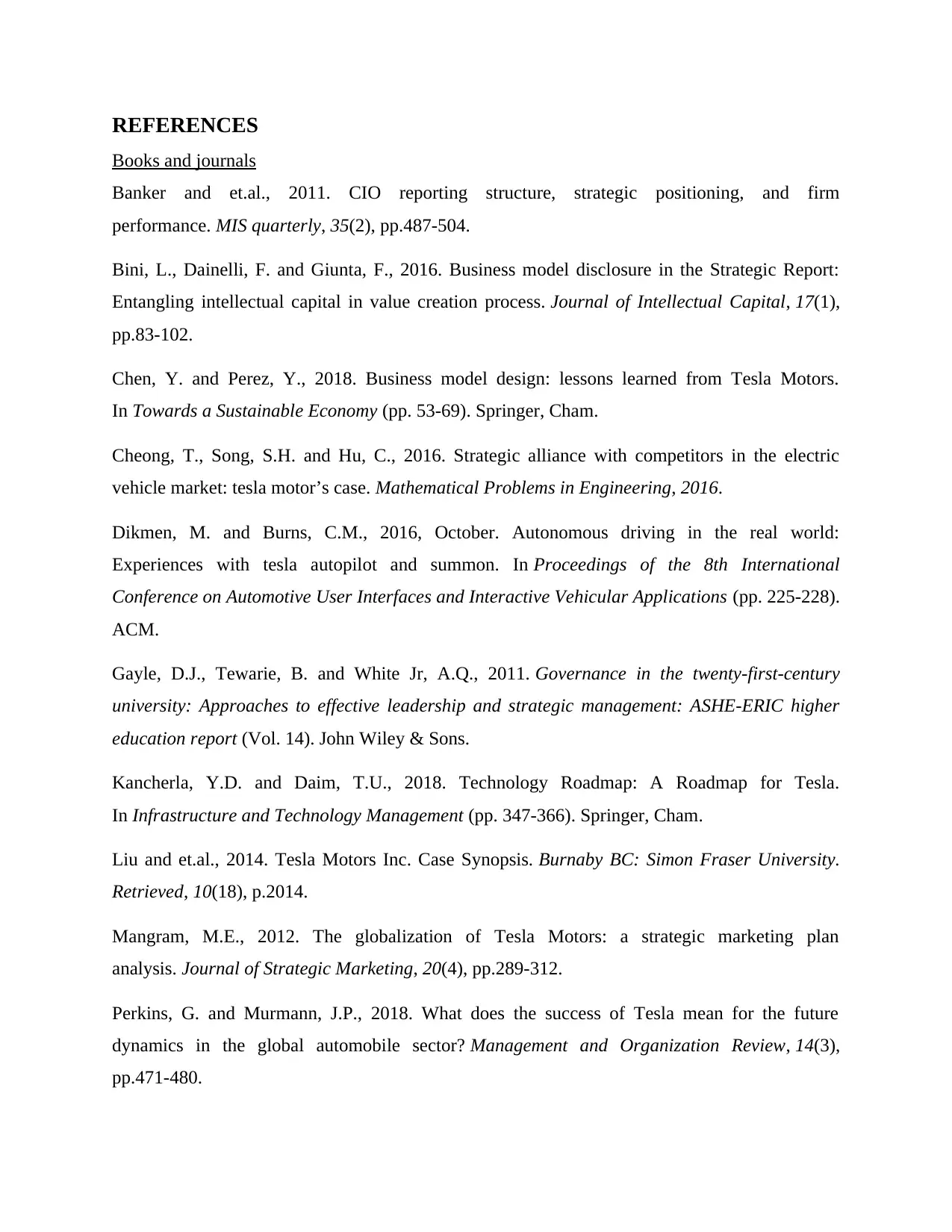
REFERENCES
Books and journals
Banker and et.al., 2011. CIO reporting structure, strategic positioning, and firm
performance. MIS quarterly, 35(2), pp.487-504.
Bini, L., Dainelli, F. and Giunta, F., 2016. Business model disclosure in the Strategic Report:
Entangling intellectual capital in value creation process. Journal of Intellectual Capital, 17(1),
pp.83-102.
Chen, Y. and Perez, Y., 2018. Business model design: lessons learned from Tesla Motors.
In Towards a Sustainable Economy (pp. 53-69). Springer, Cham.
Cheong, T., Song, S.H. and Hu, C., 2016. Strategic alliance with competitors in the electric
vehicle market: tesla motor’s case. Mathematical Problems in Engineering, 2016.
Dikmen, M. and Burns, C.M., 2016, October. Autonomous driving in the real world:
Experiences with tesla autopilot and summon. In Proceedings of the 8th International
Conference on Automotive User Interfaces and Interactive Vehicular Applications (pp. 225-228).
ACM.
Gayle, D.J., Tewarie, B. and White Jr, A.Q., 2011. Governance in the twenty-first-century
university: Approaches to effective leadership and strategic management: ASHE-ERIC higher
education report (Vol. 14). John Wiley & Sons.
Kancherla, Y.D. and Daim, T.U., 2018. Technology Roadmap: A Roadmap for Tesla.
In Infrastructure and Technology Management (pp. 347-366). Springer, Cham.
Liu and et.al., 2014. Tesla Motors Inc. Case Synopsis. Burnaby BC: Simon Fraser University.
Retrieved, 10(18), p.2014.
Mangram, M.E., 2012. The globalization of Tesla Motors: a strategic marketing plan
analysis. Journal of Strategic Marketing, 20(4), pp.289-312.
Perkins, G. and Murmann, J.P., 2018. What does the success of Tesla mean for the future
dynamics in the global automobile sector? Management and Organization Review, 14(3),
pp.471-480.
Books and journals
Banker and et.al., 2011. CIO reporting structure, strategic positioning, and firm
performance. MIS quarterly, 35(2), pp.487-504.
Bini, L., Dainelli, F. and Giunta, F., 2016. Business model disclosure in the Strategic Report:
Entangling intellectual capital in value creation process. Journal of Intellectual Capital, 17(1),
pp.83-102.
Chen, Y. and Perez, Y., 2018. Business model design: lessons learned from Tesla Motors.
In Towards a Sustainable Economy (pp. 53-69). Springer, Cham.
Cheong, T., Song, S.H. and Hu, C., 2016. Strategic alliance with competitors in the electric
vehicle market: tesla motor’s case. Mathematical Problems in Engineering, 2016.
Dikmen, M. and Burns, C.M., 2016, October. Autonomous driving in the real world:
Experiences with tesla autopilot and summon. In Proceedings of the 8th International
Conference on Automotive User Interfaces and Interactive Vehicular Applications (pp. 225-228).
ACM.
Gayle, D.J., Tewarie, B. and White Jr, A.Q., 2011. Governance in the twenty-first-century
university: Approaches to effective leadership and strategic management: ASHE-ERIC higher
education report (Vol. 14). John Wiley & Sons.
Kancherla, Y.D. and Daim, T.U., 2018. Technology Roadmap: A Roadmap for Tesla.
In Infrastructure and Technology Management (pp. 347-366). Springer, Cham.
Liu and et.al., 2014. Tesla Motors Inc. Case Synopsis. Burnaby BC: Simon Fraser University.
Retrieved, 10(18), p.2014.
Mangram, M.E., 2012. The globalization of Tesla Motors: a strategic marketing plan
analysis. Journal of Strategic Marketing, 20(4), pp.289-312.
Perkins, G. and Murmann, J.P., 2018. What does the success of Tesla mean for the future
dynamics in the global automobile sector? Management and Organization Review, 14(3),
pp.471-480.
⊘ This is a preview!⊘
Do you want full access?
Subscribe today to unlock all pages.

Trusted by 1+ million students worldwide
1 out of 13
Related Documents
Your All-in-One AI-Powered Toolkit for Academic Success.
+13062052269
info@desklib.com
Available 24*7 on WhatsApp / Email
![[object Object]](/_next/static/media/star-bottom.7253800d.svg)
Unlock your academic potential
Copyright © 2020–2025 A2Z Services. All Rights Reserved. Developed and managed by ZUCOL.





